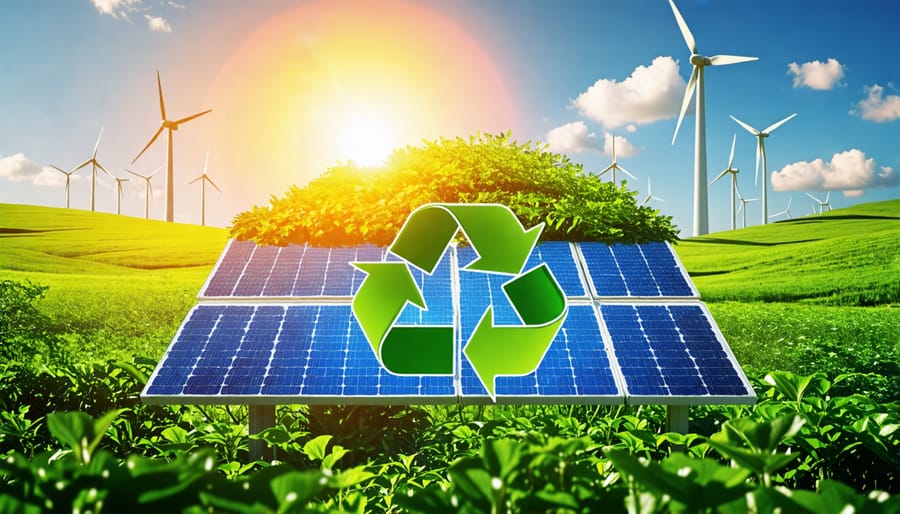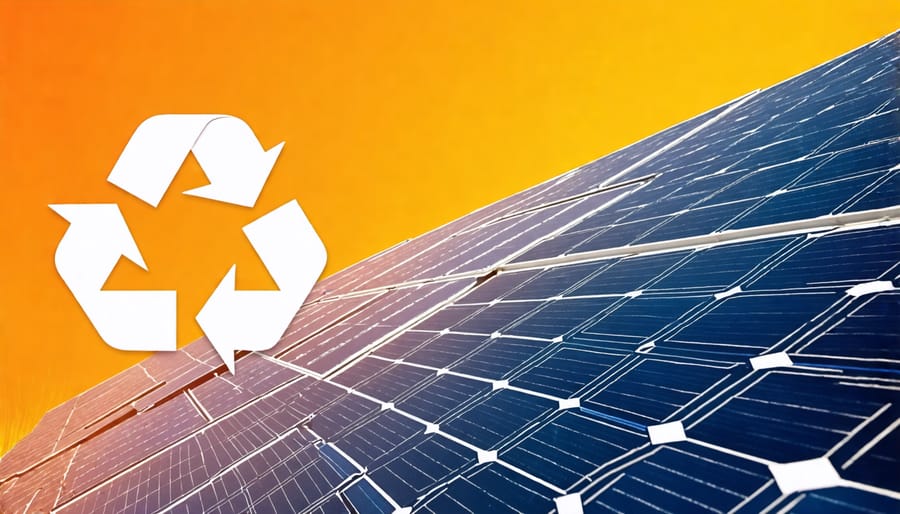Solar Panels: A Bright Future or a Looming Waste Crisis?

Discover the truth about solar panel sustainability in this comprehensive analysis. While touted as a clean energy solution, solar’s cradle-to-grave environmental impact is more complex than it first appears. From the mining of raw materials to the disposal of spent panels, we delve into the lesser-known sustainability challenges facing the industry.
But it’s not all doom and gloom – innovative companies like INOX Solar are leading the charge with cutting-edge technologies that minimize waste, maximize efficiency, and prioritize responsible sourcing. Whether you’re looking to install your own solar panels or invest in large-scale projects, understanding the full lifecycle impact is crucial for making truly eco-friendly choices.
Join us as we shine a light on solar’s sustainability story, balancing environmental benefits with real-world hurdles, and highlighting the visionary solutions paving the way to a brighter, greener future. Armed with this knowledge, you’ll be empowered to make solar decisions that align with your values and contribute to a more sustainable Europe.
The Dark Side of Solar: Materials and Manufacturing
Digging Deep: The Raw Materials of Solar
The raw materials required for solar panel production, such as silicon, silver, and rare earth elements, are primarily obtained through mining processes. While solar energy itself is clean and renewable, the extraction of these materials can have environmental impacts that must be carefully managed.
Silicon, the primary component of most solar cells, is derived from quartz sand through energy-intensive processes. However, efforts are underway to increase the use of recycled silicon and improve mining practices to minimize ecological disturbances. Silver, used in electrical connections, is a scarce resource with mining impacts that vary based on location and methods employed.
Rare earth elements, including tellurium and indium, enhance solar cell efficiency but are often obtained as byproducts of copper, lead, and zinc mining. The extraction and processing of these materials can lead to soil, water, and air pollution if not properly regulated. Encouragingly, ongoing research aims to reduce rare earth element usage and develop alternative materials.
As the solar industry grows, responsible sourcing and sustainable mining practices become increasingly critical. European initiatives, such as the Raw Materials Alliance, promote transparency, innovation, and environmental stewardship in raw material supply chains. By supporting these efforts and prioritizing manufacturers who adhere to strict sustainability standards, European consumers can drive positive change and ensure a more sustainable future for solar energy.
The Carbon Footprint of a Solar Panel
While solar energy is a clean, renewable power source once panels are installed, it’s important to consider the carbon footprint of solar panel manufacturing. The process of creating solar panels involves mining raw materials, refining them, and assembling the components, all of which require energy and generate emissions. Studies estimate that producing a solar panel results in 50-80 grams of CO2 per kilowatt-hour over its lifespan, which is still significantly lower than fossil fuels.
However, the solar industry is continuously working to reduce the energy usage of solar panel manufacturing and its environmental impact. Innovations like using recycled materials, improving energy efficiency in production, and adopting circular economy principles are helping to further decrease emissions. As technology advances and manufacturing scales up, the carbon footprint of solar panels is expected to decline even further.
It’s also crucial to consider the operational lifespan of solar panels, which is typically 25-30 years. During this time, they generate clean electricity that offsets the emissions from their production many times over. When panels reach the end of their life, proper recycling and disposal practices ensure that materials are recovered and reused, minimizing waste and environmental impact.
In the bigger picture, while solar panels are not entirely carbon-neutral, they represent a significant step towards reducing our reliance on fossil fuels and mitigating climate change. As the industry continues to prioritize sustainability and innovation, the carbon footprint of solar will continue to shrink, making it an increasingly eco-friendly energy solution for Europe and beyond.

The Looming Challenge: Solar Panel Waste
A Tsunami of Solar Trash?
As solar installations continue to expand across Europe, a looming challenge is emerging on the horizon: the exponential growth of solar panel waste. With the average lifespan of a solar panel spanning 25-30 years, many of the early installations from the 2000s are approaching their end-of-life phase. Studies project that by 2050, solar panel waste could reach a staggering 78 million tonnes globally, with Europe potentially contributing a significant portion of this figure.
While solar energy remains a cornerstone of Europe’s transition to a low-carbon future, addressing the impending wave of solar panel waste is crucial for ensuring the technology’s long-term sustainability. Proper recycling and disposal mechanisms need to be established to prevent valuable materials from ending up in landfills and to minimize the environmental impact of decommissioned panels. As the solar industry continues to innovate, the development of more easily recyclable and eco-friendly panel designs will play a key role in mitigating this challenge. By proactively addressing the issue of solar waste, Europe can set a global example for sustainable solar growth and maintain its position as a leader in the clean energy transition.
The Recycling Riddle
While solar energy offers immense environmental benefits, the question of how to sustainably handle panels at the end of their lifecycle looms large. As solar installations surge across Europe, developing efficient and economical methods for recycling solar panels is becoming increasingly critical. The complex, multi-layered construction of panels, which contain various materials like glass, polymers, and rare metals, poses significant technical challenges for recycling. Separating these components cleanly and efficiently requires innovative processes that are still being developed and refined.
Moreover, the current costs of recycling often exceed the value of the reclaimed materials, creating an economic hurdle. However, as solar waste volumes grow and recycling technologies mature, the economies of scale are expected to improve. European researchers and companies are at the forefront of developing advanced, automated recycling solutions to address these challenges head-on. By investing in cutting-edge recycling infrastructure and R&D, the European solar industry is working to close the loop on solar sustainability, ensuring that this clean energy solution leaves a minimal environmental footprint from cradle to grave.
Innovations for a Brighter, Greener Future

Cleaner Production, Longer Lifespans
In the solar industry, leading manufacturers like INOX Solar are adopting sustainable manufacturing practices to minimize the environmental footprint of panel production. This includes using recycled materials, reducing water consumption, and powering facilities with renewable energy. Concurrently, extensive research and development efforts are underway to create more durable, efficient, and longer-lasting solar panels.
By investing in high-quality materials and advanced manufacturing techniques, the lifespan of modern solar panels can extend well beyond the standard 25-30 years. This not only provides better long-term value for consumers but also reduces the frequency of panel replacements, thereby decreasing waste. Furthermore, many solar companies are now offering robust recycling programs to ensure that old panels are properly disposed of and their materials reclaimed for future use. As the industry continues to mature, we can expect even more innovative solutions to emerge, making solar an increasingly sustainable choice for Europe’s clean energy transition.
Designing for Circularity
To enhance the sustainability of solar panels, designers are embracing modular concepts and carefully selecting materials to facilitate repair, reuse, and recycling. By creating panels with easily replaceable components, manufacturers can extend the lifespan of these systems and minimize waste. Standardized designs allow for seamless upgrades and repairs, reducing the need for complete replacements. Furthermore, by choosing materials that are readily recyclable or biodegradable, such as aluminum frames and organic semiconductors, the environmental impact of solar panels at the end of their life cycle can be significantly reduced. These design innovations not only improve the eco-friendliness of solar energy but also make maintenance more cost-effective for European homeowners and businesses. As the solar industry continues to evolve, modular and recyclable designs will play a crucial role in ensuring that solar panels remain a truly sustainable solution for Europe’s clean energy future. By investing in these cutting-edge technologies, we can maximize the benefits of solar power while minimizing our ecological footprint.
Shining a Light on the Path Forward
Solar panels are a beacon of hope in our journey towards a more sustainable future. While they are not a perfect solution, their benefits far outweigh the challenges. As European homeowners, businesses, and industries, it is our responsibility to embrace this innovative technology and work together to optimize its sustainability.
The path forward lies in continued research, development, and implementation of eco-friendly materials, recycling processes, and circular economy principles. By investing in cutting-edge solar technologies and comprehensive project support, we can maximize the efficiency and longevity of solar panels while minimizing their environmental impact.
It is crucial to remember that the sustainability of solar panels extends beyond their physical components. We must also consider the broader context of their production, transportation, installation, and end-of-life management. By adopting a holistic approach and collaborating with experts in the field, we can ensure that every step of the solar panel lifecycle aligns with our sustainability goals.
As we shine a light on the path forward, let us embrace the incredible potential of solar energy while remaining committed to finding proactive solutions to the challenges we face. Together, we can build a brighter, cleaner future for Europe and the world.
Leave a Reply